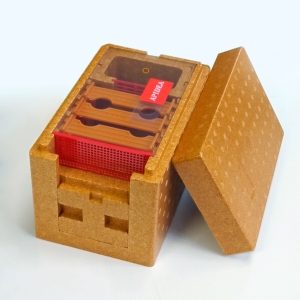W hen I first started with queen rearing I had limited success with using apideas for raising new queens and by trial and error I have improved my mating rate using the following approach:
- Stock the apidea 2 days before introducing a sealed queen cell. I am lucky to have 2 apiary sites so I use bees from one site and then place the stocked apideas in the other apiary. This seems to eliminate losing all the bees back to the parent colony.
- Fill it with a cupful (around 300) bees. To try and ensure I get nurse bees rather than foragers I lightly shake 2 brood frames into a box and leave for 30 seconds to allow flying bees to “escape”. Obviously having made sure the queen is elsewhere in the colony!
- I lightly spray the remaining bees with water to get them to clump together. Then turn the apidea upside down, remove the bottom slide and tip the clump of bees in. Close the apidea up and place it in a quiet spot in my shed.
- At this stage I fill the feeder with 2:1 syrup as I want to encourage them to draw out the wax foundation strips – hence going after nurse bees that have active wax glands.
Whilst the bees are in the shed I spray the front grille with water twice a a day. - After 2 days it’s time to introduce the sealed queen cell, usually 9-10 days after grafting. As I am grafting this is just a case of inserting the the cell holder and lodging it in place by closing the flap in the Perspex cover. I check the feeder to see if it needs topping up. I have drilled a 4 mm hole in the perspex cover to allow me to do this with a syringe rather than having to open up the apidea completely.
- 24 hours after introducing the queen cell I place the apidea in it’s permanent spot in the apiary. I open up the entrance in the evening to let the bees start to get acclimatised to their new location.
- Then I leave alone for 10 days before inspecting.
Using bees from a secondary site and concentrating on filling with nurse bees are the main reasons for my success rate going from 25% to 80%.



